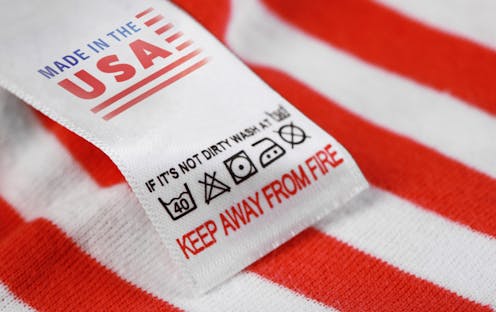Three possible futures for the global economy if Trump brings in new trade tariffs
- Written by Agelos Delis, Senior lecturer in Economics, Aston University

The last time Donald Trump was US president, he entered trade wars with China[1] and Europe[2]. But despite his bravado and tariffs, the US trade deficit did not improve.
In fact, it deteriorated from US$195 billion in the first quarter of 2017 to US$260 billion[3] in the same period of 2021.
The first round of Trump tariffs were at a maximum of 25%[4] and were slapped on a number of selected goods. But now his policy appears to be that the US will apply tariffs of 10% or 20% to most imported goods. Canada and Mexico[5] could be facing tariffs of 25% – and Chinese products might be looking at 60%.
This new proposal seems to be significantly different to the previous one. So what are the possible scenarios for the US, the UK and the global economy?
Scenario 1: Confrontation
Taking the president-elect’s word to the letter, if Trump stands his ground on across-the-board tariffs one consequence may be that the US economy faces higher prices because of more expensive imports. The demand for US-produced goods will increase, which is likely to push up domestic wages – and could end with spiralling inflation.
It is not difficult to imagine the US economy overheating rapidly. However, there are also opposing forces. Higher tariffs and large investment in the US will most likely trigger an appreciation of the dollar, meaning imports becoming cheaper at the border, before tariffs are applied. This could eat away at inflation.
Read more: Why Donald Trump's election could hasten the end of US dollar dominance[6]
In addition the promise of massive layoffs[7] in the public sector might ease the pressure on the jobs market[8]. Technological innovation – the push for driverless cars, for example – might also move things in the same direction.
Finally, relaxing environmental regulations in the energy sector[9], together with potential peace with Russia and maybe even in the Middle East, might make energy prices more affordable.
Scenario 2: The art of the deal
Donald Trump is well known for his transactional approach to politics. In terms of trade, this means it is unburdened by the international rules[10] that have governed international trade after the second world war.
The nomination of Scott Bessent[11] as treasury secretary adds to this trend. In his words, tariffs are a “sanctioning tool”[12] in wider political and economic games.
This leads to a likely scenario for future trade relations with the rest of the world where the US dangles relatively appealing terms to access its market in exchange for a wide array of potential concessions. These could include closer political alignment, large investment in the US, or more opportunities for US investment or its exports.
Overall, there could be a major restructuring of supply chains under which imports from the most efficient countries could be replaced by less efficient ones. This could cut the US’s trade deficit with China but increase its trade deficit with the EU, UK, Mexico and Canada.
A looming question is: will these deals be extended to China – and will China take them? If not, the prospect of two economic blocs – one centred around China and the other around the US – is possible.
Scenario 3: Deterrence
In a third – unlikely – scenario, the Chinese government might accept the US demands to rebalance their bilateral trade deficit in the belief that the time is not yet ripe to contest US supremacy.
Maintaining an export-led growth model, building strength, breaking into foreign markets and just sitting out the Trump presidency could be China’s best strategy. The Chinese government would have to accept larger and rapid buyouts of American-made goods and services than set out in the previous agreement between the Trump and Xi administrations[13].
But what about the UK and Europe? UK exports to the US will face a 20% tariff[15], reducing sales and impacting on those UK producers exporting goods the US buys, like pharmaceuticals or machinery, for example. The UK’s first dilemma will be whether to retaliate and introduce tariffs for US goods. And if so, at what level?
A trade war with US is not in the UK’s interests, but what happens next will depend on the conditions the Trump administration imposes. There is already talk that the UK should choose between the US or EU[16], assuming that regional trade blocs emerge because of other countries’ retaliatory moves.
The effects will be similar for the EU, although there is a significant difference. The EU as a bloc has its own trade policy and a similar-sized economy to that of the US. As such, the incentive for retaliation and a trade war between the EU and US is strong.
If the EU decides to go down that route, it will make things complicated for the UK. In this scenario, the UK would eventually need to choose a side. It would have to choose either the special relationship with the US and a further deterioration of trade[17] with the EU – its nearest market. Or it would have to opt to move politically and economically closer to the EU.
Sadly, when countries close their borders to trade, they are also – perhaps inadvertently – readying themselves for conflict.
References
- ^ China (www.bbc.co.uk)
- ^ Europe (www.europarl.europa.eu)
- ^ US$260 billion (apps.bea.gov)
- ^ 25% (taxfoundation.org)
- ^ Canada and Mexico (www.reuters.com)
- ^ Why Donald Trump's election could hasten the end of US dollar dominance (theconversation.com)
- ^ massive layoffs (www.bbc.co.uk)
- ^ jobs market (www.nytimes.com)
- ^ energy sector (markets.businessinsider.com)
- ^ rules (legal.un.org)
- ^ Scott Bessent (www.bbc.co.uk)
- ^ “sanctioning tool” (apnews.com)
- ^ Trump and Xi administrations (www.cnbc.com)
- ^ Pla2na/Shutterstock (www.shutterstock.com)
- ^ 20% tariff (www.bbc.co.uk)
- ^ US or EU (www.theguardian.com)
- ^ trade (www.ons.gov.uk)







